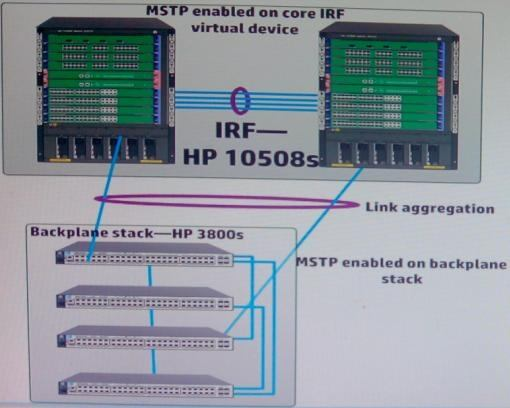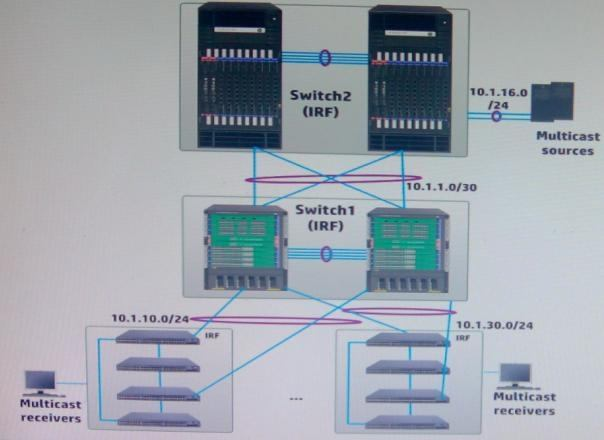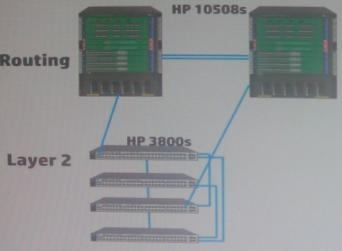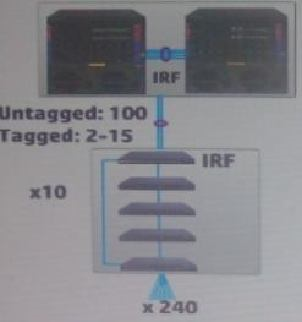Download Architecting HP FlexNetwork Solutions.HP0-Y50.PracticeTest.2018-07-29.68q.vcex
| Vendor: | HP |
| Exam Code: | HP0-Y50 |
| Exam Name: | Architecting HP FlexNetwork Solutions |
| Date: | Jul 29, 2018 |
| File Size: | 3 MB |
How to open VCEX files?
Files with VCEX extension can be opened by ProfExam Simulator.
Discount: 20%
Demo Questions
Question 1
Refer to the exhibit.

A network architect is proposing this solution to a customer. The customer network manager has a preference for Cisco VLAN Spanning Tree Plus (PVST+) because this protocol provides for fast convergence when a link fails and also provides per-VLAN load-sharing over links.
How would the network architect explain why the solution fits these requirements?
- The MSTP component of the solution fulfills the same needs as PVST+ MSTP simply balances traffic per instance rather than per-VLAN
- The redundant links between the switches are protected by MSTP and the built-in loop guard on HP-3800 switches. MSTP provides load-sharing and loop guard provides resiliency
- The solution as shown provides the same load-sharing benefits as PVST+. To achieve the same resiliency benefits, the architect can add smart link to the meshed stack
- The link aggregation between tiers provide even better resiliency and load-sharing than PVST+ while MSTP protects against accidental loops
Correct answer: D
Question 2
A network architect is explaining the differences between deploying two switches in an HP Intelligent Resiliency Framework (IRF) virtual switch and deploying two switches that implement standard Virtual Routing Redundancy Protocol (VRRP). Which statement correctly describes an advantage of IRF?
- IRF failover occurs in 3 to 4 seconds, whereas VRPF failover occurs in 10 or more seconds
- Unlike VRRP, which requires as least two addresses to be listed. Dynamic Host Configuration Protocol (DHCP) scopes list a single IP address for the default gateway
- The IRF virtual switch runs a separate routing in each member, which enhances the redundancy and reliability of the overall solution
- Multiple IRF members can actively route traffic for the same subnet and use the same IP address and routing control plane
Correct answer: D
Question 3
Which data center characteristics should specifically make the architect consider switches that support Shortest Path Bridging (SPB) or Transparent Interconnection of Lots of Links (TRILL)?
- The customer requires redundancy and resiliency for the two data center routing switches
- The customer requires high-speed routing between front-end servers and database servers in different subnets
- The virtualized data center supports several thousand virtual machines (VMs) with a two-tier networking infrastructure topology
- The data center requires many redundant links and must scale the tens of thousands of virtual (VMs)
Correct answer: A
Question 4
A network architect is planning a complete access layer and core upgrade for customer’s campus LAN. The campus has four large buildings, each requiring between 1000 and 3000 edge ports. Which factor will play a primary role in determining whether the network architect needs to plan a two-tier or three-tier topology for the campus LAN?
- The number of fiber links between each building and the building where the core switches reside
- Whether the customer requires a wireless solution
- The high number of edge ports that the solution requires
- Whether the customer can afford core switches that support intelligent Resilient Framework (IRF)
Correct answer: C
Question 5
Refer to the exhibit.

All connections between switches are 10 Gbps. Switch is an Intelligent Resilient Framework (IRF) group with two member. Switch2 is an IRF group with two members. Switch1 and Switch2 route all traffic.
A network architect is designing a solution for a finance company. One of the primary applications is a multicast application that delivers stock information to IP video screens across the site. The network architect is seeking a multicast solution that meets these needs:
- Simple configuration that the customer’s IT staff can manage and troubleshoot
- No single point of failure for the multicast traffic
What is the best solution for this environment and these needs?
- Protocol Independent Multicast (PIM) Dense Mode (DM).
- Protocol Independent Multicast (PIM) Sparse Mode (SM) with switch 1 and switch 2 configured as candidate Rendezvous Points (C-RPs), and switch1 and Switch2 also configured as Bootstrap Router (BSRs).
- Protocol Independent Multicast (PIM) Dense Mode (DM) with Switch1 and Switch2 set as the DM Master Router. Switch1 has a higher MR priority for an address associated with the multicast application.
- Protocol independent Multicast (PIM) Sparse Mode (SM) with switch1 and Switch2 set as the static Rendezvous Points (RPs). Switch1 has a higher RP priority for an address associated with the multicast application.
Correct answer: A
Question 6
Refer to the exhibit.

The branch routers have E1 lines into the Frame Relay Service provider network. The exhibit shows just one branch, but the network actually has 30 branches. The HP 6600 Series routers, which are the area border routers (ABRs), have E2 lines into the Frame Relay network.
The routers in the exhibit Open Shortest Path First (OSPF). The enable OSPF on network follows:
- In area 2, OSPF is enabled on network 10.2.0.0/16
- In area 0, OSPF is enabled on network 10.0.0.0/16
The customer requires resilience at the WAN core. Which design change best supports that requirement?
- Add additional links from the HP 6600 Series routers to the WAN
- On each branch router, add a floating static route to one of the ABRs in case the OSPF solution fails
- Add a Gigabit link between the HP 6600 Series router with a network in area 0 and area 2.
- At each branch, add a redundant link between the switch and the router
Correct answer: A
Question 7
Refer to the exhibit.

A network architect has planned redundant links as shown in the exhibit. What should the network architect do to ensure that the redundant link design is truly resilient?
- Implement the features such as link aggregation, backplane stacking, and intelligent Resilient Framework (IRF)
- Add another link between the Layer 2 switches and the core so that up to the two links can fail
- Implement a feature such as bidirectional forwarding detection (BFO) on each redundant link
- Make sure that each HP 10508 switch is configured as a root in one Multiple Spanning Tree Protocol (MSTP) instance
Correct answer: C
Question 8
A network architect is compiling information about the total cost ownership (TCO) for a proposal. Which factors play a role in TCO?
- Cost of remediation due to a future security breach
- Cost of regulatory fines associated with non-compliance
- Cost of upgrading modules for the proposal
- Cost of powering the solution
Correct answer: D
Question 9
Refer to the exhibit.

A network architect is designing the logical topology for a campus LAN networking solution. The customer requires support for 2400 edge ports, which is provided by 10 intelligent Resilient Framework (IRF) groups at the access layer. This customer does not have a wireless network nor anticipants adding one in the next two years. However, the customer does want to authenticate users with 802.1X and use the network RADIUS server to divide users from different groups into different VLANs. The customer has three user groups, each of which includes between 600 and 900 users.
Additionally, the customer understands that the RADIUS server will require several policies but wants to keep these policies as simple and easy to maintain as possible.
How can the network architect ensure that the solution meets the customer needs and also follows best practice?
- Assign a /23 subnet to each VLAN so that the VLAN can accommodate the required number of users, even if users connect multiple devices
- Plan a different VLAN ID and subnet address for each user group on each access layer IRF group. Either core or access layer routing will work for this solution
- Use access layer routing. Assign a different subnet to VLAN2 on one access layer IRF group then the VLAN2 on the another access layer group
- Plan a solution for designing dissolvable agents to the endpoints so that they can complete 802.1X authentication seamlessly
Correct answer: B
Question 10
An architect is planning an HP Wired-WLAN solution for a customer with Voice over WLAN (VoWLAN) devices, which support 5 GHz and 2.4 GHz, and the laptops. What is a potential advantage of dual-radio 802.1n APs for this environment?
- They can load balance a single phone’s traffic between the two radios
- The can use 802.1n band steering to shift only the laptops to the 2.4 Ghz radio
- They can support a single VLAN for phones and laptops, but use load balancing to move all phones to one radio
- They can support a voice WLAN on one RADIO and an employee WLAN on the other radio
Correct answer: D
HOW TO OPEN VCE FILES
Use VCE Exam Simulator to open VCE files

HOW TO OPEN VCEX AND EXAM FILES
Use ProfExam Simulator to open VCEX and EXAM files


ProfExam at a 20% markdown
You have the opportunity to purchase ProfExam at a 20% reduced price
Get Now!



